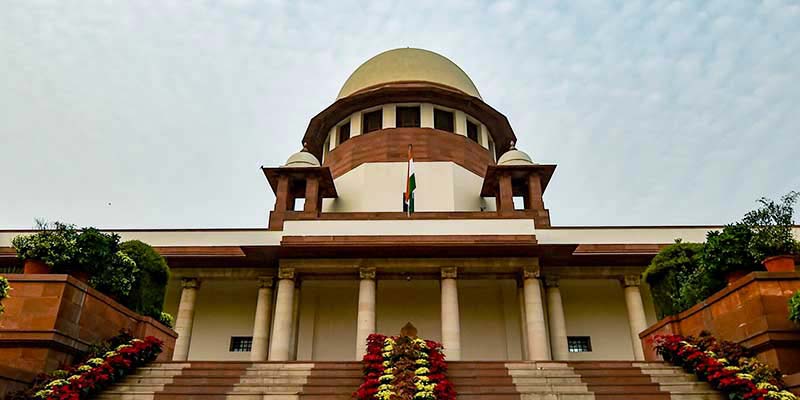- India
- Aug 26
Nagaland govt files plea in SC against Lokayukta
Last week, the Supreme Court agreed to hear a plea filed by Nagaland government which has raised questions over the functioning of Lokayukta in the state.
A bench headed by Chief Justice S.A. Bobde issued notice on the plea filed by the state government.
The state government, in its plea, has urged the apex court to pass appropriate direction in exercise of its power under Article 142 of the Constitution to ensure that the institutional integrity of the post of Nagaland Lokayukta and the spirit of the Nagaland Lokayukta Act, 2017 are preserved.
Article 142 of the Constitution deals with enforcement of decrees and orders of the Supreme Court and says that in exercise of its jurisdiction, it may pass order for doing complete justice in any matter pending before it.
What is the purpose of Lokayukta?
The First Administrative Reforms Commission (ARC) was set up in January 1966 to examine the public administration of the country and make recommendations for reform and reorganisation when necessary.
The Commission was headed by Morarji Desai. When Morarji Desai became the deputy prime minister, K. Hunmanthaiya became its chairman.
The Commission submitted 20 reports and it contained 537 major recommendations.
One of major recommendations was the establishment of an Ombudsman Institution at the central and state level for redressal of citizens grievances by investigating into administrative actions taken by or on behalf of the governments or certain public authorities. These were intended to serve as institutions independent of the government and to supplement the judicial institutions headed by chief justices or judges of the Supreme Court or High Courts.
The recommendation was made to improve the standards of public administration, by looking into complaints against administrative actions, including cases of corruption, favouritism and official indiscipline in administrative machinery.
Odisha was the first state to enact a law — Odisha Lokpal and Lokayuktas Act, 1970. However, the state implemented it only in 1983.
In 1972, Maharashtra became the first state in India to establish Lokayukta.
Since then, most states have passed Acts to establish Lokayukta to improve the standard of public administration through investigation against public functionaries.
Lokpal and Lokayuktas Act, 2013 provides for the establishment of a body of Lokpal for the Union and Lokayukta for states to inquire into allegations of corruption against certain public functionaries and for matters connected therewith or incidental thereto.
The governor of a state appoints Lokayukta/Upa Lokayuktas. The term of the Lokayukta is normally five years. In Uttar Pradesh, it is eight years.
Once appointed, a Lokayukta cannot be dismissed nor transferred by the government. Lokayukta can be removed by only passing an impeachment motion by the state assembly.
What is Article 142?
Article 142 deals with enforcement of decrees and orders of the Supreme Court.
It states that, “The Supreme Court in the exercise of its jurisdiction may pass such decree or make such order as is necessary for doing complete justice in any cause or matter pending before it, and any decree so passed or orders so made shall be enforceable throughout the territory of India in such manner as may be prescribed by or under any law made by Parliament and, until provision in that behalf is so made, in such manner as the President may by order prescribe.”
Section 2 states that “Subject to the provisions of any law made in this behalf by Parliament, the Supreme Court shall, as respects the whole of the territory of India, have all and every power to make any order for the purpose of securing the attendance of any person, the discovery or production of any documents, or the investigation or punishment of any contempt of itself.”
Recent cases invoking Article 142
* On November 9, 2019, the Supreme Court in the judgment on the Ayodhya title dispute used special powers granted in the Article 142 of the Constitution. Though the disputed 2.77 acres of land was awarded for a temple, based on the evidence, the top court invoked the powers of Article 142 to grant five acres for a mosque in Ayodhya.
* The SC bench also invoked this Article to grant relief to Nirmohi Akhara and sought its inclusion on the trust formed by the Centre under Section 6 of the Ayodhya Act to construct the temple.
* In October 2019, the Supreme Court exercised its inherent powers under Article 142 of the Constitution to annul a marriage of an estranged couple, residing separately for over two decades, saying it was a case of irretrievable breakdown of wedlock.
* In December 2015, the Supreme Court appointed a former high court judge Justice Virendra Singh as Uttar Pradeshs Lokayukta after the state government failed to comply with its directives. The UP government failed to meet the Supreme Court deadline to appoint Lokayukta even after two rounds of marathon talks, which failed to come up with a consensus name.
Manorama Yearbook app is now available on Google Play Store and iOS App Store

